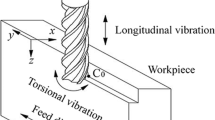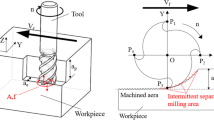Abstract
Milling of the titanium alloy thin-walled workpiece is a critical challenging task and the machining vibration is a major effect on the accuracy of the final part due to difficult machining properties and low stiffness. The common milling (CM) is very hard for titanium alloy thin-walled parts to get high-quality machined surface microstructure, so finding an effective way of processing to obtain better surface microstructure is particularly important. In this article, the longitudinal-torsional composite ultrasonic vibration-assisted milling (LTCUVM) is proposed to overcome the problems of the common milling. The cutting method of the high-frequency vibration separation of a workpiece and the tool reduces an average cutting force. Thereby suppressing the tool relieving and further providing a good machined surface. In this study, firstly, the kinematic model of LTCUVM was established and the variations of the movement of the cutting edge flank with the spindle speed change were analyzed. Then the finite element model (FEM) of the two processing methods was developed and significant differences between the CM and LTCUVM in the micro-milling were revealed. Further, related experiments were designed and conducted. Finally, the experimental analysis showed that the LTCUVM effectively reduced an average cutting force, and further reduced surface roughness and height of chatter marks compared to the CM with the same processing parameters.
Similar content being viewed by others
References
Thepsonthi T, Özel T (2015) 3-D finite element process simulation of micro-end milling Ti-6Al-4V titanium alloy: Experimental validations of chip flow and tool wear. J Mater Process Technol 221:128–145
Zhao Xiao Q (2009) Features and special processing method for difficult-to-cut material in aviation industry. Aeronautical Manufacturing Technology 23:50–51
Ferry W, Yip-Hoi D (2008) Cutter-workpiece engagement calculations by parallel slicing for five-axis flank milling of jet engine impellers. J Manuf Sci Eng 130(5):383–392
Ye HT, Zhang JZ, Yang JF et al (2012) Key application technology of cutting for aircraft difficult-to-machine material. Aeronautical Manufacturing Technology 10:44–46
Meshreki M, Attia H, Kö Vecses J (2011) A new analytical formulation for the dynamics of multipocket thin-walled structures considering the fixture constraints. J Manuf Sci Eng 133(2):021014
Bolar G, Das A, Joshi SN (2018) Measurement and analysis of cutting force and product surface quality during end-milling of thin-wall components. Measurement 121:190–204
Smith S, Dvorak D (1998) Tool path strategies for high speed milling aluminum workpieces with thin webs. Mechatronics 8(4):291–300
Sui H, Zhang X, Zhang D, Jiang X, Wu R (2017) Feasibility study of high-speed ultrasonic vibration cutting titanium alloy. J Mater Process Technol 247(19):120–127
Harada K, Sasahara H (2009) Effect of dynamic response and displacement/stress amplitude on ultrasonic vibration cutting. J Mater Process Technol 209(9):4490–4495
Ma C, Shamoto E, Moriwaki T, Wang L (2004) Study of machining accuracy in ultrasonic elliptical vibration cutting. Int J Mach Tools Manuf 44(12–13):1305–1310
Xiao M, Sato K, Karube S, Soutome T (2003) The effect of tool nose radius in ultrasonic vibration cutting of hard metal. Int J Mach Tools Manuf 43(13):1375–1382
Nath C, Rahman M (2008) Effect of machining parameters in ultrasonic vibration cutting. Int J Mach Tools Manuf 48(9):965–974
Shen XH, Zhang JH, Xing DX, Zhao Y (2012) A study of surface roughness variation in ultrasonic vibration-assisted milling. Int J Adv Manuf Technol 58(5–8):553–561
Muhammad R, Ahmed N, Demiral M, Roy A, Silberschmidt VV (2011) Computational study of ultrasonically-assisted turning of Ti alloys. Adv Mater Res 223:30–36
Patil S, Joshi S, Tewari A, Joshi SS (2014) Modeling and simulation of effect of ultrasonic vibrations on machining of ti6al4v. Ultrasonics 54(2):694–705
Ali Moaz H, Khidhir BA, Ansari MNM, Mohamed B (2013) FEM to predict the effect of feed rate on surface roughness with cutting force during face milling of titanium alloy [J]. HBRC Journal 9.3:263–269
Ducobu F, Arrazola PJ, Rivière-Lorphèvre E, Filippi E (2015) Finite element prediction of the tool wear influence in Ti6Al4V machining. Procedia Cirp 31:124–129
Pantalé O, Bacaria J-L, Dalverny O, Rakotomalala R, Caperaa S (2004) 2D and 3D numerical models of metal cutting with damage effects. Comput Methods Appl Mech Eng 193(39–41):4383–4399
Molinari A, Musquar C, Sutter G (2002) Adiabatic shear banding in high speed machining of Ti–6Al–4V: experiments and modeling. Int J Plast 18(4):443–459
Kay (2002) Failure modeling of titanium6al4v and 2024-t3 aluminum with the Johnson-Cook material model. Technical Rep
Zhao W, He N, Li L (2006) Finite element analysis of orthogonal cutting of Ti6Al4V alloy in enhanced cooling condition. J South China Univ Techno: Nat Sci Ed 34(7):40–44
Yao YQ, Guo YM, Zhu L et al (2004) Numerical simulation for effect of friction coefficient under high-speed cutting by FEA. J Eng Des 11(1):31–36
Meng L (2013) Finite element modelling on high-speed milling process of titantum alloy. Shanghai Jiao Tong University, Shangghai
Alavi SH, Cowell C, Harimkar SP (2016) Experimental and finite element analysis of ultrasonic vibration−assisted continuous-wave laser surface drilling. Adv Manuf Process 32(2):216–225
Cheng J, Jin Y, Wu J, Wen X, Gong Y, Shi J, Cai G (2016) Experimental study on a novel minimization method of top burr formation in micro-end milling of ti-6al-4v. Int J Adv Manuf Technol 86(5–8):2197–2217
Tao G, Zhang J, Shen X, Bai L, Ma C, Wang J (2016) Feasibility study on ultrasonic vibration assisted milling for squamous surface ☆. Proced Cirp 42:847–852
Funding
The study received financial support from the Henan Natural Science Foundation (162300410120).
Author information
Authors and Affiliations
Corresponding author
Rights and permissions
About this article
Cite this article
Tong, J., Wei, G., Zhao, L. et al. Surface microstructure of titanium alloy thin-walled parts at ultrasonic vibration-assisted milling. Int J Adv Manuf Technol 101, 1007–1021 (2019). https://doi.org/10.1007/s00170-018-3005-7
Received:
Accepted:
Published:
Issue Date:
DOI: https://doi.org/10.1007/s00170-018-3005-7




